Many people believe that full, prominent cheeks look more attractive and feminine. With thin, sunken cheeks, the face looks as if emaciated, thin, and the woman loses her attractiveness. This face looks older. Cheek augmentation can restore fullness, facial attractiveness and rejuvenates the face by tightening the skin. In addition, cheek augmentation can be combined with cheekbone plastic surgery, since sufficiently prominent cheekbones are often associated with feminine beauty and emphasize the fullness of the cheeks.
It is believed that high cheekbones are beautiful. But such cheekbones may not suit everyone, so you need to take into account the shape of the face and the entire head. Currently plastic surgery offers different ways cheek enlargement.
Typically, during surgical cheek augmentation and cheekbone surgery, synthetic implants are used, which are successfully used for plastic surgery in other areas of the face. For non-surgical cheek surgery, various biopolymer gels are used. In this case, implants are installed in the cheekbone area, which, in turn, leads to an increase in the shape of the cheeks.
Who is suitable for cheek augmentation?
Cheek augmentation is suitable for people with reduced cheek volume, when they seem to be retracted, sunken, either initially or as a result age-related changes. This plastic procedure will help those who want to enlarge their cheeks, make them more convex and voluminous. Some patients may have previously undergone contouring using various polymer gels, and now want a permanent effect - they are also shown cheek augmentation using implants. Patients who are planning plastic surgery must be healthy, without any concomitant diseases, with normal blood clotting and without infectious processes on the skin of the face.
Surgical technique for installing implants for cheek augmentation
Cheek surgery can be performed either separately or in combination with other plastic procedures, for example, cheek surgery, face lift, nose job, etc. Different implants can be used for cheek surgery, different shapes and sizes to the best way improve cheek fullness and facial contours. Depending on the area and goals of the plastic surgery, cheek implants can be installed through a small incision in the mouth, on the gum, or through the lower eyelid if the operation is combined with a lift. lower eyelids. Depending on the approach and preference of the surgeon, a cheek or zygomatic implant can be made of solid silicone or other inert materials, such as Medpor. Surgically a pocket is created for installing the implant above the zygomatic bone, after which the implant is placed in it. The implant is held either by the pocket itself or pressed against soft tissues or zygomatic bone. Next, the incision is sutured, and drainage tubes are left in the wound to prevent hematomas, seromas and accumulation of pus. Typically, the entire operation lasts 30 - 45 minutes, unless the intervention is combined with other operations.
In addition, there is surgical plastic surgery of the cheekbones, aimed at eliminating sunken cheeks without the use of implants. It is called meloplication or subcutaneous cheek lift. For meloplication, two incisions are made, with one incision made on the side of the oral cavity, and the second usually in the temple area, behind the hairline. The fat pad of the cheeks is removed through an incision in the mouth. Using a gripping suture, this pad of fat is pulled under the skin to an incision in the temple area. In this way, the fatty pad of the cheek and the corner of the mouth are lifted. This is also accompanied by smoothing of the nasolabial fold.
Advantages and disadvantages of cheek implants
- Unlike bioplymer gels, implants allow achieving a permanent effect
- The use of implants can be easily combined with other plastic interventions
- Intraoral or eyelid approach
- Large selection of implant shapes and sizes
Non-surgical methods for cheek enlargement
The patient may not always agree to incisions and implants in the facial area. In this case, contour plastic surgery of the cheekbones and cheeks can be successfully used. It is based on the use of biopolymer gels. In addition, instead of gels, it is possible to use the most natural plastic material - the patient’s own adipose tissue. This type of contouring can be an alternative to implants. But, unlike implants, the effect of contouring with gels or your own fat is short-lived.
In cheek augmentation and cheekbone plastic surgery, gel preparations based on hyaluronic acid and collagen. Their advantage is that they are natural components of the body. Hyaluronic acid has the ability to retain moisture in the skin, giving it youth, and collagen fibers provide it with elasticity.
When such gels are introduced into the skin, they seem to fill it from the inside, smoothing out all wrinkles and age-related folds. The main effect of such contouring is to add volume where it is lacking, and in addition, the use of gels allows you to add brightness, definition and expressiveness to the cheekbones and improve the overall appearance of the skin, giving it youth. Among the advantages of biopolymer gels for contouring of cheeks and cheekbones is their non-displacement over time.
Another group of gels for contouring the cheeks and cheekbones includes materials based on synthetic polymers made of silicone and biopolymer gel. They have more long lasting effect unlike collagen and hyaluronic gels, but they have a drawback - they are much more difficult to inject under the skin, and the risk of complications becomes higher. From common shortcomings The gel technique for cheek augmentation is the formation of a fibrous capsule when using biopolymers and silicone, as well as the risk of displacement of such gels. And the effect of gels based on collagen and hyaluronic acid is extremely short-lived.
It is worth saying a little about the use of the patient’s own fat for contouring. This method is considered the simplest and safest, and at the same time relatively effective, but the most short-lived compared to other methods of cheek enlargement, since the fatty tissue is absorbed over time.
Despite this, cheek plastic surgery and their enlargement with the help of injection materials can be successfully used to improve the shape of the oval of the face, smooth out hollow cheeks and make the face youthful and attractive.
Disadvantages and risk of complications of cheek implants
When using incisions in the facial area, nerve branches may inevitably be crossed, resulting in temporary or permanent loss of sensation.
Implants in the facial area can become dislodged, especially on early stages after operation. Due to the risk of injury, vigorous exercise and sports should be avoided to avoid this complication until the wound has completely healed.
When using an incision in the lower eyelid area to install an implant, retraction of the lower eyelid is possible, which leads to a feeling of dry eye. If a cheek or zygomatic implant becomes infected, it may require removal.
Preparing for surgery
Before plastic surgery to enlarge the cheeks, as before others surgical interventions, preparation and a complete examination of the patient is carried out. First of all, the doctor collects anamnesis, asks about previous diseases and operations, incl. in the facial area. Be sure to tell your doctor if you are allergic to any medications, especially anesthetics. In addition, tell your doctor if you are taking this moment any medications, especially aspirin or other anti-inflammatory drugs. Conducted general analysis blood and urine biochemical tests blood, and blood clotting is determined and an ECG is performed.
Before the operation, the doctor must take your photograph so that the patient can compare the result obtained from the operation with what happened before it. Two weeks before surgery, you should stop smoking for a while, as nicotine negatively affects wound healing.
Recovery period after cheek surgery
Usually the current recovery period after cheek surgery depends on the chosen method and combination with other interventions. In general, after cheek augmentation surgery, you may experience numbness in your upper lip, similar to a visit to the dentist. During the day this feeling goes away. There is some soreness and swelling in the cheek area. Typically, the doctor prescribes painkillers and antibiotics after surgery to prevent infectious complications. In bed, it is recommended to keep your head elevated, that is, on a high pillow, to avoid swelling in the face. If the implant was inserted through the oral cavity, the doctor may prescribe you a diet for a couple of days, as well as rinsing your mouth with an antiseptic until the stitches dissolve. When using an incision in the lower eyelid area, your doctor will explain to you how to care for it, give it rest, and what medications to use to relieve dryness. Facial stitches are usually removed after a week.
Anesthesia for cheek surgery
Typically, the installation of implants or the introduction of contouring gels is carried out under local anesthesia. At first after surgery, there may be a feeling of fullness and tightness as a result of the implant pulling on the skin. As the swelling subsides, this sensation intensifies, so painkillers are usually used for several days.
Do scars remain after cheek surgery?
When incisions are made in the mouth to create a pocket for the implant, the incision is usually not visible because it is in the mouth. When an incision is made in the lower eyelid area, the scar remains in the crease of the lower eyelid. Usually this cut remains almost invisible, even if you look closely.
What are the possible disadvantages of cheek surgery?
Usually in the early postoperative period There may be a loss of sensitivity on the face in the area of the incisions, which is associated with the inevitable intersection of nerve branches. This feeling can be either temporary or permanent. There is pain, which can be relieved with painkillers.
Among the complications are the following:
- Formation of hematoma in the cheek area.
- Infectious complications - suppuration, inflammation.
- Delayed wound healing (usually in smokers and patients with diabetes).
- Skin sensitivity disorders.
- Risk of complications of anesthesia (allergies).
- Damage to deep facial structures - nerves, blood vessels, muscles.
- Displacement of the implant and unevenness of the skin contour in the area of the cheekbones and cheeks.
Bartsok-gymnastics course for the face
When we talk about face-building exercises for the face, the name itself suggests that this program gives you the opportunity to shape your face. Changing the face at will provides, first of all, a gymnastics exercise for the cheeks, with which the cheeks can be made thinner or plumper, the face will look narrower or wider. You can, for example, achieve a more cheeky face or, conversely, less. This is a face building exercise for the buccal muscle of the face. This face-building exercise for the face is strikingly different from the fashionable “puffing out” of the cheeks, which leads to new wrinkles. A high-quality and regularly performed exercise for the cheek muscle will tighten the cheeks so as not to bite the cheek from the inside; such gymnastics for the cheeks can transform your face, not create, but reduce wrinkles near the corner of the mouth and nasolabial fold. But the main task of this exercise is to prevent or remove sagging cheeks.
To prepare and perform cheek gymnastics exercises, you need a mirror, attention and careful monitoring of the progress of the workout, as well as clean face and hands and, of course, the desire to achieve the goal. To learn how to perform the exercise correctly, without the risk of harming yourself, you will need 20-30 minutes. If your goal is to change the shape of your face, then a little more. The exercise in the future will take about 1 minute, or a minute and a half if using audio support.
What can be achieved by regularly performing this face building exercise:
- lifting the cheeks, reducing sagging cheeks;
- changing the shape of the cheeks according to your choice;
- increasing the density and elasticity of the cheek skin;
- reduction of nasolabial folds and folds near the corner of the mouth.
If mastering the exercise on your own is difficult, take advantage of the opportunity of distance learning and take the lesson you need via Skype.
The exercise is done in an isometric form: muscle strengthening occurs without stretching the skin.
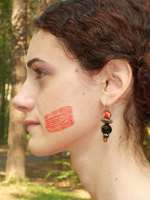 The buccal muscle is wider and lies deeper than the other cheek muscles. It is this muscle, together with the skin, that makes up the bulk of the mass of the cheeks. The buccal muscle creates the shape of the cheek, participates in the sucking process, and pulls the corners of the mouth back. The muscle is attached to the upper and lower jaws, with the other end intertwined into the upper and lower lip, skin of the lips and corners of the mouth. The muscle contracts due to the formation of folds at the bottom of the cheek and near the corners of the mouth.
The buccal muscle is wider and lies deeper than the other cheek muscles. It is this muscle, together with the skin, that makes up the bulk of the mass of the cheeks. The buccal muscle creates the shape of the cheek, participates in the sucking process, and pulls the corners of the mouth back. The muscle is attached to the upper and lower jaws, with the other end intertwined into the upper and lower lip, skin of the lips and corners of the mouth. The muscle contracts due to the formation of folds at the bottom of the cheek and near the corners of the mouth.
This paired facial muscle is distinguished by its large area and its deep position. It also performs an additional function unusual for facial muscles, being a sucking muscle. In infants, for whom this function is vital, large cheeks indicate the strength of the cheek muscle. Over the years, this function disappears, and the cheek muscle is practically not used. Therefore, over time, gradual sagging of the cheeks occurs, and the cheeks begin to bite from the inside.
With the help of the cheek muscle you can express skepticism, mistrust, and misunderstanding. A constantly skeptical facial expression indicates chronic tension in the cheek muscle or significant residual tension on it. In this case, muscle tension produces permanent folds near the corner of the mouth.
If the cheek muscle is not used, then the cheeks droop so that sometimes the cheeks are bitten from the inside, and the sliding of the weakened muscle downwards under the influence of gravity leads to the skin of the edges of the lips and in the area of the corner of the mouth sliding down. Then folds appear or deepen near the corner of the mouth, and the nasolabial fold may also deepen.
Training the cheek muscle will make it stronger, restore the normal position of the muscle, eliminate deviations in local blood circulation and skin nutrition, slow down the aging of the skin, increasing its firmness and elasticity, stop its stretching, and prevent the formation or deepening of wrinkles and folds. Obviously, gymnastics for the cheeks allows you to pump up the cheek muscle, significantly increasing the density of the cheeks, and make the cheeks thinner if you stop the training as soon as the excess subcutaneous fatty tissue on the cheeks is burned.
By learning to clearly feel the tension of the cheek muscle, you will learn to get rid of residual muscle tension, completely relaxing it immediately after use, and for this reason the skin will no longer stretch and create wrinkles.
How can you “pump” the cheek muscle? This muscle is well trained not only in babies, but also in trumpet players, and the first thing that comes to mind is to forcefully inflate the cheeks. However, this simple method has obvious disadvantages. Negative consequences: the skin of the cheeks will stretch and, inevitably, in the area where the muscle is woven into the skin at the edges of the lips, as well as under the eyes, wrinkles will appear. Therefore, it is better to train the cheek muscle without stretching the skin in a static position, in which muscle tension is balanced by finger pressure.
The training method proposed in face-building exercises for the face also makes it possible to exercise not only the entire muscle, but also individual segments of this broad muscle. You can increase its mass under the cheekbones or below, on the right or left, near the nose or on the periphery. Since the shape of the cheeks, and therefore, to a large extent, the appearance of the entire face, depends on the shape of this muscle, with targeted training of the cheek muscle you can change your face.
Preparing for a gymnastics exercise for the cheeks.
Part 1.
 Look at the photo above and imagine where the cheek muscle is located under your skin. Close your lips and teeth. Press your cheeks firmly against your teeth. Depending on where you press, you will get tension in different areas of your cheek. To train the entire cheek muscles, it is better to press them against the molars. Now look at yourself in the mirror - you should have a skeptical expression on your face. Since you are training the sucking muscle, you should also feel increased salivation. Feel the tension in your cheeks near the corners of your mouth.
Look at the photo above and imagine where the cheek muscle is located under your skin. Close your lips and teeth. Press your cheeks firmly against your teeth. Depending on where you press, you will get tension in different areas of your cheek. To train the entire cheek muscles, it is better to press them against the molars. Now look at yourself in the mirror - you should have a skeptical expression on your face. Since you are training the sucking muscle, you should also feel increased salivation. Feel the tension in your cheeks near the corners of your mouth.
Now try to make maximum tension on the cheek muscle, pressing your cheeks to your teeth as hard as possible. When you feel tension, relax the muscle. Try to feel a flow of relaxation going to the corner of your mouth and lips. When you feel the corners of your lips relax, you can be sure that you have completely relaxed the muscle.
Part 2.
 Training of the cheek muscle should take place at its maximum tension, but with blocking its contraction with your fingers, preventing the skin from shifting and the formation of folds. Straightened and shifted together middle and ring fingers(or the middle and index fingers, or all three fingers, if that’s more convenient for you), with their pads they should press down and immobilize the cheek muscle, preventing the cheeks from rising and forming folds. The fingers press strictly inward.
Training of the cheek muscle should take place at its maximum tension, but with blocking its contraction with your fingers, preventing the skin from shifting and the formation of folds. Straightened and shifted together middle and ring fingers(or the middle and index fingers, or all three fingers, if that’s more convenient for you), with their pads they should press down and immobilize the cheek muscle, preventing the cheeks from rising and forming folds. The fingers press strictly inward.
Looking at yourself in the mirror, place your fingers on your cheeks in the indicated manner, gently pressing them onto the skin. Close your mouth and press your cheeks against your molars, increasing finger pressure as the tension in your cheek muscles increases.
Try to tense your cheek muscle as hard as you can. It is at maximum tension that the muscle will train, strengthen and restore its position.
Look carefully at the reflection of your face. This is the only way you can see the slightest shift in the skin and make adjustments to the position and work of your fingers and hands.
Gymnastics exercise for the cheeks.
Looking carefully at yourself in the mirror, place your fingers in a way that is comfortable for you. The fingers lie softly and press slightly inwards.
In this exercise, you should press your cheeks against your closed teeth as hard as possible, but the pressure of your fingers should be sufficient and not excessive, just so that the skin of the cheek cannot move and form folds, especially in the corners of the mouth and under the eyes.
By increasing the force of tension in the cheek muscle, you simultaneously increase the force of finger pressure. To help your cheek muscle tighten more, try to contract the muscle as you inhale. Mentally help the muscle try to overcome the resistance of the fingers. Pay more attention to the right or left muscle if you feel that one of them is weaker.
Carefully watch your face in the mirror: your face should remain tense but motionless during the exercise. Don’t let the muscles of your forehead and eyebrows tense, and your lips shouldn’t tense either. All facial muscles, except the cheek muscle, remain relaxed when tense.
Count down 6 seconds to yourself and, at the same time as you exhale, release tension from the muscle by slightly moving your fingers away from the skin of your face. Feel the movement of relaxation along your cheeks to the edges of your lips.
Repeat the exercise 4-5 more times with breaks of 2-3 seconds between tensions.
You may find it convenient to practice with audio accompaniment reminding you of what to pay attention to during the exercise. “Audio Support: Cheek Muscle Exercise” is designed for such an activity.
Muscle fatigue after training can be helped by one of the audio recordings:
airy face
Face massage
About training the cheek muscles to change the shape of the cheeks.
This exercise can be used not only to strengthen the cheek muscle, to tighten the cheeks, or to avoid biting the inside of the cheek. Try pressing your cheeks against your other teeth, upper or lower; you can also unclench your teeth or open your mouth slightly. Feel the area of maximum tension moving across your cheeks. Select the part of the cheek where you would like to increase the mass and find a way to press the cheeks to the teeth that suits your task. As the center of tension in the muscle moves, you must also move the point of finger pressure.
Regular training of the cheek muscles.
Lifting the cheeks or preventing sagging cheeks, returning the cheek muscle to normal tone, changing the shape of the cheeks, eliminating folds without losing mobility and expressiveness of the face and improving the quality of the skin is a task that can only be accomplished by doing gymnastics of the facial muscles. This will reduce the sagging of your cheeks towards your teeth, and you will stop biting your cheek from the inside. To perform these tasks, you need regular training and patience to restore muscle strength, local blood circulation and skin nutrition, and even more so, to increase its mass. To achieve these goals, it is advisable to do the exercise 5-6 times a week, gradually increasing the number of approaches to 10-12. With such regularity, a visible effect can be achieved after several months of training. Formation new form cheek lift may take longer than a cheek lift, or the training may need to be more intense.
To maintain the tone of the cheek muscles, the quality of the skin and the youth of the cheeks, to prevent sagging cheeks, and to prevent the increase in skin folds, it is enough to train 1-2 times a week. Your skin will become more elastic, and you will easily notice and remove the slightest remaining tension.

How to lose weight in your cheeks and what needs to be done to make them smaller? These questions worry all women and men who do not know how to get rid of chubby cheeks. This problem is very serious and unpleasant, since large cheeks distort the real shape of the face and visually add a couple of kilograms excess weight our figure. Let's find out how to remove fat from problem area Further.
Fat cheeks - reasons

If you want to lose weight in your cheeks quickly, you first need to figure out why they look plump. And only then will you be able to understand what needs to be done to solve this problem.
Often the causes of large cheeks are:
- Excess body weight.
- Hormonal treatment.
- Unbalanced diet.
- Swelling due to a certain disease.
Sometimes the cheeks and cheekbones can be visually enlarged due to the shape of the face, for example, rectangular or round.
Many women and men try to solve the problem of chubby cheeks too quickly. For example, they are looking for ways to remove cheeks in a week. But for such short term this is impossible to do, and in addition, it is important to take into account all the characteristics of the body.
Unfortunately, if you are experiencing health problems, or are undergoing a certain course of treatment, reducing your cheeks with simple ways will not help. In addition, fat is not always the cause of voluminous cheeks. Facial swelling or hormonal imbalance can also make cheekbones and cheeks appear larger. However, if they have become unattractive due to poor nutrition and improper care of your face - everything can be fixed!
The right diet will make your cheeks smaller

Proper nutrition is a guarantee of a slim figure. By following healthy eating habits and knowing your portion sizes, you will never face the problem of being overweight.
Avoid the following list of foods and drinks in your diet:
- Alcohol (especially beer).
- Instant coffee with milk powder.
- Pasteurized juices.
- Delicious baked goods.
- Candies.
- Dairy desserts (glazed cheese curds, yoghurts, curd mass).
- Sausages and smoked meats.
- Sauces (ketchup and mayonnaise).
It is these foods that cause plump and large cheeks. This food contains chemical composition and is high in calories. Therefore, in the body it so easily turns into fat and is successfully deposited on the cheeks, chin and other parts of the body.
The following products are considered less dangerous, but also harmful to health:
- Pasta.
- Canned food.
- Cheeses (over 30% fat content).
- Potato.
- Jams and jams.
Addiction to harmful products leads to excess weight. Foods high in calories turn into fat, which can be actively deposited on the most vulnerable parts of our body: face, arms, stomach and thighs.
Workouts for weight loss

If you have sagging cheeks and large cheekbones due to excess weight, diet and facial exercises will not eliminate your problem. To solve it completely, comprehensive measures are needed. Physical exercise And proper diet will help reduce total weight body, which will also stimulate the reduction of your cheeks.
At overweight body, you should not neglect sports, because weight loss and elasticity of facial skin depend on them. Often, the diet does not remove fat from your body, but removes fluid from the body, which leads to short-term weight loss. In addition, after losing weight through diet alone, you risk having saggy, flabby cheeks and cheekbones. And all because due attention was not paid to sports.
In order to lose weight, you need to do. One of these is cardio training. It is recommended to do it for 20 minutes a day, consistently 3-4 times a week. After cardio, strength exercises should be performed - 20 and stretching - 5-7 minutes.
Chubby cheeks make you look younger and look very attractive. How to make your cheeks plump? There are two options: natural methods and cosmetic procedures. In this article we will look at the first group - what is available to everyone.
- Shea butter and sugar scrub. Mix ghee shea butter (1 tbsp.) with granulated sugar (3/4 tbsp.). Store the mixture in the refrigerator until it hardens. The scrub is applied to the face after washing, left for 5 minutes and rinsed off. warm water. Shea butter improves skin elasticity, allowing it to look younger and fuller. Sugar perfectly cleanses dead cells, as a result of which the skin ceases to look dull and emaciated.
- Moisturizers and emollients: lotions and creams. They should be applied after a shower and after each wash, allowed to dry naturally and not rinsed off.
- Cheek pinching. This must be done carefully in the up and down directions. This won't physically enlarge your cheeks, but it will create a natural flush that makes them look fuller.
- If you are wondering how to get plump cheeks, yoga exercises can help you with this. Sit straight in a chair, pull your shoulder blades down, relax your shoulders, your chest should open forward. Open your mouth slightly as you would when speaking normally, and at the same time tuck your lower and upper lips inward to cover your front teeth. The corners of the mouth should be pulled back, as close to the molars as possible, while the chin moves forward slightly. This expression should be held for about 30 seconds, then return the face to a free position.
- Apples. The antioxidants they contain, such as vitamins A, B, and C, as well as elastin and collagen, will help your skin become soft and elastic. Moreover, they can be used both internally and externally. In the first case, in addition to eating and drinking squeezed juices, you can use a drink of 3 slices of apples, 3 carrots and 0.5 tbsp. lemon juice, which are whipped with a blender until smooth. This drink is consumed daily in the morning. For the mask, a whole apple is cut, peeled, beaten or kneaded to a sauce consistency, applied in a circular motion to the cheeks, left for up to 30 minutes and washed off with warm water. The procedure should be repeated daily.
- Aloe. Its gel is applied and rubbed in for 30-60 minutes, then washed off. Another option is to drink a glass of aloe juice (edible only) in the morning.
- Glycerin and rose water. Mix the ingredients in equal parts and wear every evening. Glycerin helps maintain moisture and affects the rate of cell division, and rose water soothes and moisturizes irritated skin.
- Honey. This component acts as an excellent moisturizer and also fills the skin with antioxidants that protect it from harmful emissions and bacteria. Honey-based masks are very effective. For example, honey and papaya, mixed in equal proportions, are applied for 10 minutes and washed off with warm water. Taking honey internally, for example, 1 tbsp, is also effective. l. daily or 1 tsp. at breakfast.
- Eating vegetable oils. Very useful in this regard olive oil and pine nuts.
- Eliminating bad habits. Smoking and alcohol cause the skin to lose elasticity.
If for some reason the listed options for making your cheeks plump do not suit you or you need the fastest possible result, you can resort to cosmetics:
- blush with shimmer;
- surgical fat tissue transplantation;
- injections.
In any case, to achieve positive result you need standard components: desire and patience. And everything will work out for you, and your cheeks will be as plump as you want!
Message quote
Sagging cheeks especially age and disfigure the face. It doesn’t matter what caused the oval of the face to swell: natural aging, rapid weight loss, bad habits, poor heredity, weakened muscle tone, gravitational ptosis- any representative of the fair sex will be looking for a way to get rid of sagging cheeks.
By regularly and carefully performing the suggested exercises, you will achieve clear facial contours. Results should take a little longer than . Don't give up, results will definitely come. Your patience and work will be crowned with success - I firmly promise you this.
If your cheeks are very drooping, it is better to perform all the exercises in this group.
BASIC EXERCISES
"Chicken"*****
This is very important exercise. It strengthens the lower part of the cheeks and prevents them from sagging. If deviations already exist, then with the help of this exercise you will “tighten” your cheeks, just like after cosmetic surgery. After full course(ten weeks) your face will look so rejuvenated that your friends will ask you: “What have you done to your face? You look so young." You well deserve these compliments. Only through your patience and perseverance will you look young and attractive. The main thing is don't expect quick results and continue to do the exercises until results appear, and I repeat, they will definitely come.
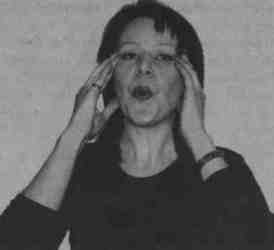 |
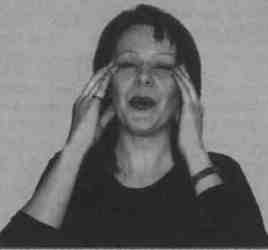 |
First phase
Smile and try to say “O” at the same time, carefully forming the sound with your lips. Don't lower the corners of your mouth. Your fingers should rest on your temples. Squeeze the muscles in your lower cheeks as hard as you can, hold the tension for five seconds, then relax. After three seconds, start the exercise again. First, perform the exercise five times in a row. Increase the number of repetitions daily until you can perform it correctly and without difficulty fifteen times in a row.
Intensive phase
During the intensive phase, the rhythm accelerates. Tension should last two seconds, relaxation should last one second. Triple the number of repetitions.
Third phase
Tension - five seconds, relaxation - three seconds. Perform the exercise five times in a row three times a week.
"Smile"*****
This extremely important exercise will make your cheeks firm and round. If you have fine wrinkles in the upper part of the cheeks, they will gradually disappear. By performing this exercise, you set in motion large group muscles. If you do it correctly and regularly, all the depressions and bulges on your face will be leveled out, your cheeks (especially sagging ones) will become stronger and give your face a youthful and youthful appearance. attractive appearance. It's very easy to do.
 |
 |
First phase
Smile from ear to ear with full force. The fingers are located at the temples and on both sides of the mouth. Tighten your cheek muscles very tightly. When you reach the highest point of tension, count to five, then relax. After a pleasant three-second relaxation, begin the exercise again. Do it five times in a row at first. Increase the number of repetitions daily until you can do it fifteen times in a row without difficulty.
Intensive phase
When you have mastered the movements described above, perform the exercise at an accelerated pace: tension should last no more than two seconds, relaxation should last one second. The number of repetitions must be tripled.
Third phase
Ten weeks later, having already reached desired results, perform the exercise three times a week with tension for five seconds, relaxation for three seconds.
ADDITIONAL EXERCISES
"Hamster"***
This exercise, like the previous ones, strengthens the lower part of the cheeks. The contours of your face will be rounded and, as a result, your face will look much younger
 |
 |
First phase
Say “A” while trying to close your mouth at the same time. You will feel your cheek muscles tighten. Tighten the lower part of your cheeks with all your might, count to five, relax, and repeat the exercise after three seconds.
Do the exercise five times in a row, adding more exercises every day until you bring the number to twelve.
Intensive phase
Having mastered the exercise well, speed up the pace: tension - two seconds, relaxation - one second, at the same time increase the number of repetitions.
Third phase
During this phase, slow down the rhythm and reduce the number of exercises. Tension lasts two seconds, relaxation lasts one second. Do the exercise five times in a row three times a week.
"Sound I"***
This exercise also strengthens the lower cheeks and shapes the oval of the face.
 |
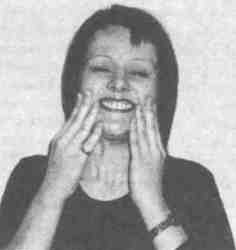 |
First phase
As you say “I,” tighten your cheek muscles as hard as you can. Place your fingers at the corners of your mouth. Hold the tension for five seconds, after three seconds start the exercise again and so on five times in a row. Increase the number of repetitions to ten, adding one each day.
Intensive phase
You have already learned how to perform the exercise correctly and without difficulty ten times in a row. Now you need to speed up the rhythm and triple the number of repetitions. Tension lasts two seconds, relaxation lasts one second.
Third phase
Perform the exercise five times in a row three times a week in a slow rhythm: tension - five seconds, relaxation - three seconds.
IF SAGGY CHEEKS STILL REFUSE TO OBEY
If you are over sixty and have severely sagging cheeks, all of the exercises described above will help you significantly alleviate this disadvantage. If you want to finally deal with the “tanks”, try the following exercises.
Exercise 1
Sit up straight, open your mouth. Pull your lower lip tightly over your teeth and wrap it behind your teeth. Press the corners of your lips to your molars and secure them there. Upper lip should remain firmly pressed against the upper teeth. Use the corners of your lips to raise and lower your lower jaw (like a dredge). Imagine that you are lifting something heavy with your jaw. With each scoop, raise your chin 1 cm. Imagine the sides of your face rising. Keep your palms at a distance of about 1 cm from your cheeks and help them move the energy field of your face upward. At this time, the head leans back freely. Now the chin “looks” at the ceiling. Continue to “scoop” slowly, imagining the sides of your face being pulled up. If you perform this exercise correctly about six times, you should feel muscle pain. Maintain this position and count to twenty.
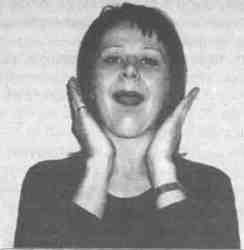 |
 |
This exercise should be performed at least twice a day every day.
Exercise 2
This exercise is especially useful for narrow thin face. By doing it, you train a large muscle group. As a result, sunken cheeks are filled out and cheek muscles are tightened.
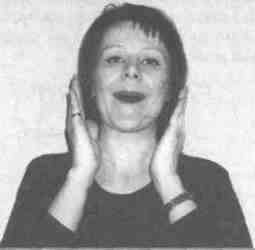 |
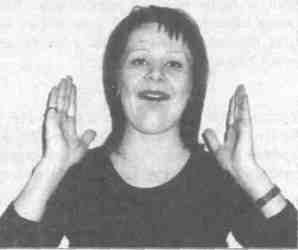 |
Open your mouth, press the corners of your lips to your molars. The upper lip is pressed against the teeth. Place your fingertips at the corners of your lips and slowly move them away from your face. Continue maintaining the position, continuing to slowly move your arms away until you feel muscle pain. Then raise your head about 2 cm. Now your hands are about 5 cm from your face. Count to 35 while doing fast circular movements palms near the face to increase tension.
Do this exercise twice a day every day. If you have a wide full face, it is better to abandon this exercise.
